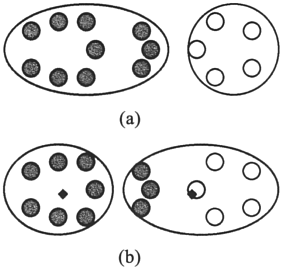62.
| [Cover] [Contents] [Index] |
Page 153
That is, the union operation compares two membership grades of two fuzzy subsets and chooses the larger one. For instance, if there are two fuzzy subsets denoted by A and B each contains two membership grades as A= {0.2, 0.9}, and B={0.5, 0.4}, then the union of A and B will become A  B={0.5, 0.9}.
B={0.5, 0.9}.
Intersection ( ) of G and H is denoted by μG
) of G and H is denoted by μG  H and is expressed by:
H and is expressed by:
 |
(4.11) |
This is the converse of the union operation. Using the same example as previously, the intersection operation A  B gives the result {0.2, 0.4}. Both the union and interaction operations have their particular usage in manipulating a fuzzy system, as described in Section 4.4.
B gives the result {0.2, 0.4}. Both the union and interaction operations have their particular usage in manipulating a fuzzy system, as described in Section 4.4.
4.2 Fuzzy c-means clustering algorithm
The ISODATA clustering algorithm (Chapter 2) is a crisp clustering procedure because it outputs membership grades of either 0 or 1 for each pixel in respect of each class. Methods such as ISODATA assume that clusters can be adequately represented as spherical patterns in feature space, and that the mean of each cluster can be estimated reasonably. Figure 4.2 illustrates an example of a possible invalid clustering. A more robust clustering method is clearly needed in this and similar situations. The fuzzy c-means algorithm (Bezdek, 1981; Bezdek et al., 1984) provides a means of over-coming the false clustering problem. This algorithm separates data clusters

Figure 4.2 (a) Two clusters shown by blank and shaded balls, (b) Possible invalid clustering result generated by ISODATA. The lozenges (in black) denote two cluster centres.
| [Cover] [Contents] [Index] |
EAN: 2147483647
Pages: 354